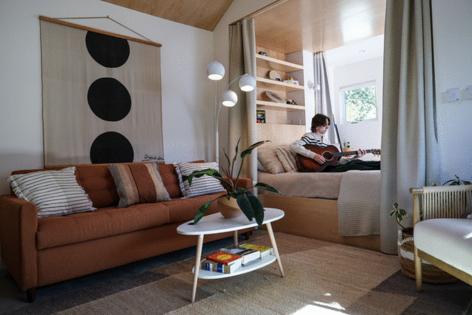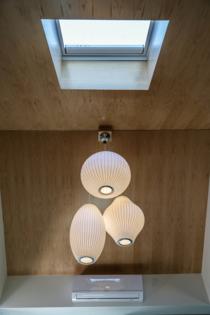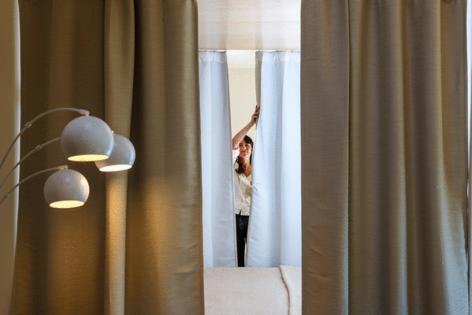She couldn't afford a bigger house in LA. So she built a stylish ADU for $230,000
Published in Home and Consumer News
LOS ANGELES -- When Kille Knobel and her then-husband bought a Midcentury ranch house in Glendale for their family of five, the thought of updating the home, which was in a good school district but had been flipped on the cheap by an investor, didn’t even cross their minds.
Knobel, an Emmy-nominated lighting designer who has worked with acts such as Pearl Jam, Soundgarden and Cher, was busy raising three boys under age 4, including two born with congenital sensorineural hearing loss. “There was no time for house projects,” Knobel says. “We just needed to survive.”
Ultimately, it would be a slow process to improve things.
Fifteen years later, as their lives changed, the couple divorced and the boys became teenagers, the 1,500-square-foot house began to feel dated and cramped. “It’s tight in the house with three boys,” Knobel says, “but there is no way I could afford a bigger house in this neighborhood.”
Many parents like Knobel understand the challenges young adults and aging parents face trying to live comfortably and affordably in Los Angeles, which is among the least affordable metro areas for renters.
As a member of the sandwich generation, Knobel longed to accommodate her kids, including her oldest son, Mason, 19, who attends college locally, and her parents, who visit frequently from out of state.
Thanks to California laws making accessory dwelling units, or ADUs, considerably more accessible to permit, Knobel decided to take cash out of her home while interest rates were low in 2021 and transform her detached two-car garage into an ADU for roughly $230,000.
“I built this for my parents,” Knobel says as she offers a tour of the 533-square-foot ADU behind the main house. “I wanted them to have a safe and comfortable place to stay, and now, if they want to stay longer, they can.” Before she added the ADU, her parents slept in a workspace converted to a guest room. “It had no plumbing or bathroom,” she says. “I worried about them reentering the house from the backyard in the dark to go to the bathroom.”
Architect Jonathan Rieke and designer Emily Mohr of MR Studio Architecture originally conceived the two-car garage as a one-bedroom unit. But with building costs skyrocketing post-COVID, they decided to go with a less expensive studio.
“When we started running numbers, I was sick about how much things would cost,” Knobel says. “We compared building costs, and I knew the finishings — cabinets, lighting fixtures and hardware — would make or break this place. I wanted to ensure money was left in the bank so we didn’t have to cut corners.
Today, their budget-friendly choices seem savvy as you walk through the stylish studio, which features a central living area below a vaulted, maple-lined ceiling and a dramatic sleeping niche that accommodates a California King mattress.
“It was so important for me to have the space feel peaceful,” Knobel says of the sun-drenched studio. “I didn’t want anything too jarring. My parents love it. The ADU is everything I wanted for them.”
Lined with integrated curtains on either side of the bed, the niche is inspired by Knobel’s time spent traveling in a tour bus with Pearl Jam, whom she has worked with for 25 years. “I have spent much of my career touring as a lighting designer,” Knobel says. “When sleeping on a tour bus, you can close the curtains for privacy and darkness.” The result is the same in the ADU: The curtains can be drawn to provide privacy for sleeping or when more than one person uses the compact space.
To save money, the designers kept the existing garage’s concrete floor slab intact and added a 170-square-foot addition at the back of the structure to accommodate the new utilities. A small top slab unifies the addition.
“It was Kille’s idea to keep all of the new plumbing in the addition so we wouldn’t have to trench through the existing slab,” Mohr says. “So the sink, the gas for the stove and washer, dryer and the bathroom are all included in the addition.”
Still, the project faced challenges such as a sump pump issue that prompted outrageously high bids from contractors. “We looked for a long time to find someone to work within our budget,” Mohr says. “Since the site slopes down, we needed a sump pump to get the sewage to the street, and once we found a contractor who knew how to do it, it was simple.”
The unit features a full kitchen with green IKEA cabinets, Caesarstone countertops and a stackable washer and dryer at the back across from the bathroom. Because there was not enough room for a dining room table, Mohr designed an efficient bar next to the kitchen overlooking the backyard. This priority was always to maximize space and functionality. “It was important to create a place to work and eat,” Knobel says of the kitchen nook. “Even though this is just a studio apartment, the kitchen is always the heart and soul of a home.”
While the intent was to create a tranquil main space, Mohr describes the bathroom as “a fun zone” with warm wheat-tone brick tiles on the wall and dark gray terrazzo cement tile with warm brown aggregate flooring. “We took a chance on the terrazzo tile,” she says, “because it had more texture.”
To add further warmth, the designers installed maple plywood on the ceiling of the central living room, which balances the concrete flooring. “Even when we were looking to reduce cost, we hung on to the wood as we knew its warmth would make a big difference,” Mohr says.
As a designer, Knobel says lighting was important to her, and she spent a lot of time picking out fixtures, adding dimmers and installing under-the-counter lighting in the kitchen. She had her heart set on a Herman Miller Nelson triple bubble lighting fixture in the main living area and was crushed when it proved too costly for her budget.
So when Mohr found an Instagram post that noted the Herman Miller Nelson triple bubble lighting fixture was on sale at the DWR outlet in Oxnard, Knobel got in her car, drove 70 miles and purchased the pendant at a discount.
“We looked at alternatives, but nothing took my breath away like this pendant,” she says.
Working together came naturally to Knobel and Mohr, whom the lighting designer describes as “an absolute sleuth.”
“She would find such beautiful things and could always find things that were a little less expensive,” Knobel says appreciatively. “It was a huge collaboration.”
“We had a lot of Google sheets,” Mohr adds with a smile.There were other insights into Knobel’s design brain as well. “Kille invited us to see Pearl Jam two months ago, and it was so special for us to see her design process.”
Although renting the ADU is not a priority for Knobel right now, she likes having options as she moves forward. “Should that need arise, we are near the JPL [NASA’s Jet Propulsion Laboratory] and in a good school district. But I might be more inclined to rent the front house and live in the ADU.”
She imagines all her sons will cycle through the ADU. These days, her son Mason Stucker is living in there, and when his grandparents come to town, he moves back in with his mother and brothers. It might be small, but it has enough room for a desk where he can study and his musical instruments.
Stucker says he enjoys the privacy and closeness of home, and is glad that his two younger brothers have their own rooms. “It’s so peaceful here,” he says. “It feels very private and separate. I can do my homework, make music and be alone. It’s giving me an introduction to adult living.”
This pleases his mother, who says that one of her goals for the ADU was for her sons to have a taste of independence. “But guess who shows up at dinner every night?” Knobel says jokingly. “I don’t think he’s turned the stove on once.”
©2024 Los Angeles Times. Visit at latimes.com. Distributed by Tribune Content Agency, LLC.













Comments